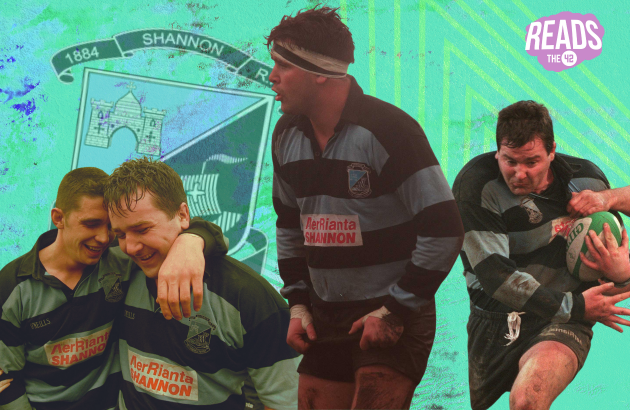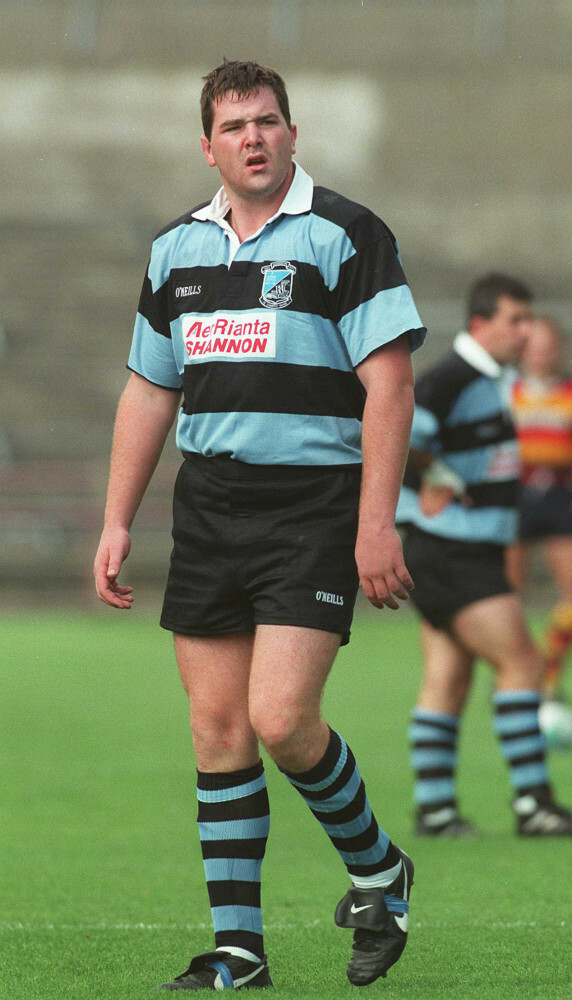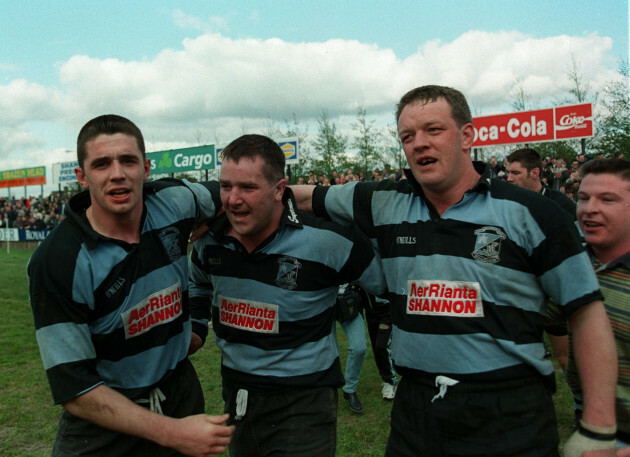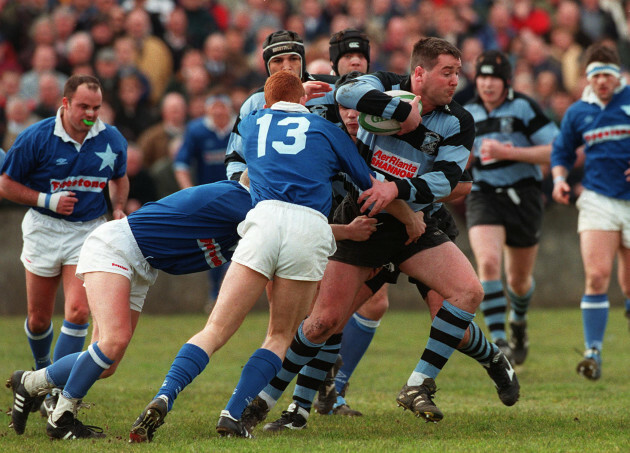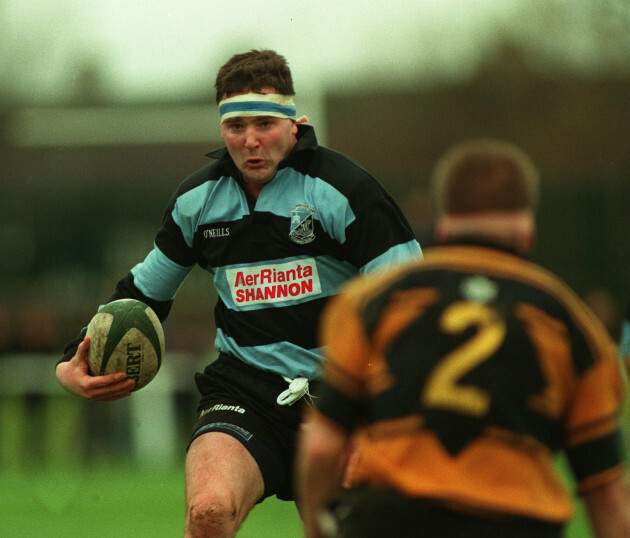IT WAS 1994 and Shannon were up in Cratloe Woods for a fitness session.
Alan Quinlan had joined the club from Clanwilliam with a growing reputation, but he felt like a skinny, scrawny young fella in this mix of U20 and senior players.
There were plenty of grizzled, experienced hard men among the Shannon crew but Quinlan found himself more in awe of the 20-year-old Anthony Foley.
He had heard plenty about Foley but as he fell in behind the number eight during the run, Quinlan was blown away by the sheer size of his big, square back.
“All I could think was, ‘My God, he’s a monster!’” says Quinlan. “He was probably as big at that age as when he finished his career.”
Quinlan took pride from playing alongside Foley over the years that followed as Shannon won four consecutive All-Ireland League titles and he never stopped looking up to ‘Axel,’ whether it was on the pitch as his team-mate or watching him make his Munster and Ireland debuts.
“I’d be just thinking ‘I want to be like Axel,’” says Quinlan.
Of course, it had long been established that Foley was a huge prospect within Shannon. His father, Brendan, is a club legend who helped them to back-to-back Munster Senior Cups in the 1970s, was in the Munster team that beat the All Blacks in 1978, and won 11 caps in the second row for Ireland.
- For more great storytelling and analysis from our award-winning journalists, join the club at The42 Membership today. Click here to find out more>
Anthony was omnipresent in Shannon from the age of four, tagging along to Brendan’s training and games, always there in the changing room among the smell of Deep Heat and grown men, all of it kick-starting a deep appreciation for club rugby – a grá that never left him even as professional rugby took over.
Anthony started playing in the Shannon underage system but it was when he went off to St Munchin’s College, 25 minutes in the road from the family home in Killaloe, that it became clear just how talented he was.
“By the time he was captaining the Junior Cup team, everyone knew about him,” says Billy O’Shea, who played alongside Foley in Shannon’s AIL-conquering team of the ’90s.
“He was a big ball-carrying number eight, he was kicking to touch, he was place-kicking, pretty much putting the flags out before games! You name it, he was doing it.”
Marcus Horan was four years behind Foley in Munchin’s and looked up to him as a “man mountain.” When Horan later followed Foley into senior rugby with Shannon, he took pleasure in being picked up by Anthony and Brendan in his home village of Cloonlara on their way through from Killaloe to training. There was never a shortage of stories.
“I felt like I was with rugby royalty with the two boys in the car,” says Horan.
“They just lived it. I remember Axel talking about watching his dad play, some of the historic games he played in, and then realising that Axel had a sister, Rosie, who played as well. They were just steeped in rugby.”
As Anthony shone for the St Munchin’s Senior Cup team – with Brendan coaching him – and nearly helped the Ireland Schools to beat a famous New Zealand team on their 1992 tour, there was excitement in Shannon about getting their hands on him.
Still, when 18-year-old Foley arrived for senior training on the back pitch at Thomond Park at the start of the 1992/93 season, he had plenty to prove. Before even getting a chance to play for Shannon, Foley had to show he could front up against seriously tough men like Mick Galwey, Mick Fitzgibbon, and Kieran Maher in training.
“From day one, he was well able to look after himself,” says O’Shea.
Pat Murray, who captained Shannon to the first three of their four-in-a-row and coached them for the fourth, was similarly impressed at how ready Foley was to play senior rugby.
The AIL – which launched in 1990 – had quickly become a huge deal in Irish rugby and Foley made his debut against a Young Munster team that went on to lift the trophy in that 92/93 season. The ‘Cookies’ were an uncompromising side with stars like Ger Earls, Ger and Peter Clohessy, and John ‘Paco’ Fitzgerald. A proper proving ground.
“There were no cameras back then,” says Murray. “It was a different type of rugby. If you had the jersey on your back coming off, you were lucky, but you were well scarred.”
An old head on young shoulders, Foley showed that nothing could faze him.
“He was never, ever intimidated,” adds Murray. “He always went forward, no matter who he was up against.”
Shannon lost that day but Foley’s performance made it easy for the Limerick Leader and other media to deliver glowing reports about his talent the following Monday morning.
Axel was up and running but Shannon were struggling and had to beat Garryowen on the last day of the season to avoid relegation. Foley took over at number eight from Niall O’Donovan, who moved into the head coach role, and Shannon survived again in 93/94.
Ahead of the 94/95 season, the club was finally in good order. O’Donovan proved to be a brilliant head coach, while Brian O’Brien – Shannon’s first Ireland international – was manager, and young players like Foley, Quinlan, John Hayes, and Andrew Thompson had broken through. Shannon’s approach became far more professional.
They took off irresistibly and went unbeaten that season as the back row of Quinlan, Foley, and Eddie Halvey made a big impact behind the powerful Shannon tight five, although Foley probably needed a pair of earplugs at times.
“Axel used to say it was like having two stereos on either side of him continuously blazing,” says Quinlan. “We would be chattering, nattering, and never shutting up really. Axel used to just laugh at us.”
Foley was a rampant presence from number eight, with his parents, Brendan and Sheila, and his sisters, Rosie and Orla, always offering their support as he made a name for himself.
Noel Healy, who played with Brendan and then came out of retirement in his 30s to play with Axel during the four-in-a-row, loved being part of the same team. Many of Shannon’s tactics were built around Foley.
“My job as tighthead was to keep an angle on the scrum, half a yard up on the right-hand side and that would mean Foley could break,” says Healy. “Any time I got up from the scrum, I was going forward and you’d be shattered by the time you caught up with Anthony.”
Foley was hot property at the age of 21 and he was picked for his Ireland debut against England in the first game of the Five Nations in January 1995. Tradition dictated that he should rest up the weekend before as Shannon played rivals Blackrock in the AIL. There wasn’t a hope Foley was going to miss it.
“Sure I’ll have a week to get ready for England,” he told everyone as they urged him to prioritise his first Ireland cap. Foley was outstanding as Shannon notched a crucial win and then he scored a try against the English the following weekend at Lansdowne Road.
“I was only a young lad underage with Shannon,” says Horan, “but you heard those stories and always looked up to how rugged and tough he was. He always put the team first.”
That Blackrock game is famous for a much-disputed try by O’Shea, who hacked the ball through and found himself in a race with Niall Woods. Foley later wrote in his autobiography that O’Shea got a fingertip of downward pressure on the ball in that scramble in the pouring rain, but Blackrock folk would still argue otherwise.
“I got the touchdown alright, but we don’t need to go into that too much!” says O’Shea with a laugh.
“It was trench warfare, they had a hell of a set of forwards too. They were a mean, mean bunch. Foley earned his stripes up front that day.”
Shannon went on to claim their first AIL title, following in Garryowen and Young Munster’s footsteps, and it proved to be the first in a streak of four. These were the glory days of the AIL and in Limerick, it was the only show in town. Win and you could walk the streets of the city with pride, lose and you would take a fierce slagging.
“When we played Munsters, there would be 10,000 people or more at the games,” says Murray.
There were busloads of supporters, family, and friends who followed Shannon around the country, then filled the clubhouse every Saturday night. Foley simply loved the atmosphere of those heady days. Shannon was everything to him.
“Foley and the rest of us used to get energised by the crowds, it was just phenomenal,” says Healy, who was Shannon president when Foley passed away five years ago.
Foley also loved the craic that was part and parcel of the game back then. He understood the importance of a team being united on and off the pitch, with no one left behind.
Horan recalls the scale of what became Shannon’s annual AIL celebrations in those years. Saturday night, Sunday all day, back again on it on Monday, and maybe beyond.
“I remember having to go into college on the Monday one year and I got a call from Axel: ‘Where are you?’
“So I arrived up to Flannery’s and my college bag was lobbed into some storeroom and I had to go back for it a couple of days later.”
On Henry Street in Limerick, there was a ‘golden triangle’ in those days. Shannon frequented a pub called Morgan’s, Young Munster had the Corner Flag across the street, and Willie Sexton’s was a Garryowen spot 50 yards down the road.
The second year Shannon won the AIL, 95/96, it initially appeared they had left themselves short. Garryowen only had to beat or draw with Young Munster to claim the title in their final AIL game of the season, which kicked off half an hour before Shannon got underway in a Cup match against UCC down in Cork.
On the sideline in Cork, Shannon fans were glued to their radios and exploded with joy as word came through that the Cookies had beaten Garryowen. Shannon were champions.
“We were celebrating on the field and our cup game still had to be won!” recalls Murray.
That night, back in the golden triangle, Foley and co. were at the centre of the raucous scenes.
“You can imagine what that little 50-yard stretch was like that night,” says O’Shea.
“We started in Morgan’s but spilled across the street to the Corner Flag to celebrate with Munsters. Things were a lot quieter 50 yards down the road in Willie Sexton’s.”
Foley adored the Limerick rivalries and had great respect for the other clubs. Healy recalls himself and Foley clapping the Cookies off the train in Limerick following their AIL success in 1993 then heading for a few pints in appreciation of the achievement.
But despite his calm demeanour on the pitch, Foley despised losing.
“He was the same in the golf, the two of us used to play,” says Healy with great fondness. “He was desperate when he lost.”
Foley continued to deliver outstanding performances for Shannon across the course of their four titles, showing remarkable durability to play in every single one of the 48 games of those four campaigns.
“He’d make linebreaks, bosh people away, and he could see things other people couldn’t see – his reading of the game was second to none,” says Quinlan. “He found himself in the right place so often because of that rugby intelligence.”
And yet, Foley was one of a few Shannon men who fell out of favour with Ireland later in the 90s when Brian Ashton was in charge. Feeling that Ashton didn’t put value the AIL enough, it only made Shannon more motivated to succeed.
Foley took over the captaincy for the last of the four-in-a-row seasons in 97/98, leading them to victory over Garryowen in front of a huge crowd in the final at Lansdowne Road as play-offs came in for the first time, while Shannon also got one over the Cookies in the Munster Senior Cup final that season.
In the years that followed, Munster were getting their act together as professionalism properly took hold in Ireland and the demands with province and country soon meant Foley was pulled away from Shannon.
“That kinda hurt him because he loved playing for the club,” says Quinlan, and the Heineken Cup soon became the holy grail for everyone in Munster.
But Foley never forgot his roots. He would be back at Shannon whenever possible, whether posing for pictures, helping out with coaching, or simply supporting the club he loved.
“I remember him coming to a Shannon match when he was coaching Munster and I planned to meet him with everyone else on the west side of the pitch,” says Murray.
“I texted him and asked where he was. He was hiding away over in the east stand. He didn’t have to be out front but he was there watching. That was typical, he was there but he didn’t need to be seen.”
The club was rocked by Foley’s death in 2016 and they have honoured him every day since, even they know his humble nature means he wouldn’t be too keen on the tributes and articles like this one.
A bust of Axel has pride of place in the Shannon clubhouse at Thomond Park, while stories about Foley are part of every gathering. His wife, Olive, and sons, Tony and Dan, are very much part of the club too.
When Ballynahinch visited for an AIL game last weekend, Foley was mentioned in the post-match speeches and his presence always looms comfortingly large. Munster will look to do him proud against Connacht in Thomond Park today, as will Shannon in their AIL visit to City of Armagh.
“This club is a family,” says Healy. “Shannon is a workman’s club and a workman’s club it will always be.
“What the Foleys have done for Shannon RFC is huge. Brendan first, then Rosie, then Anthony, and his sons might be back to play after school. I’ll be on the sideline talking to Anthony if that happens.
“I loved Anthony Foley, I really did.
“Once you turn up to Shannon rugby club, you see the bust and you know that Anthony’s memory will always be alive.”
For more great storytelling and analysis from our award-winning journalists, join the club at The42 Membership today. Click here to find out more>
